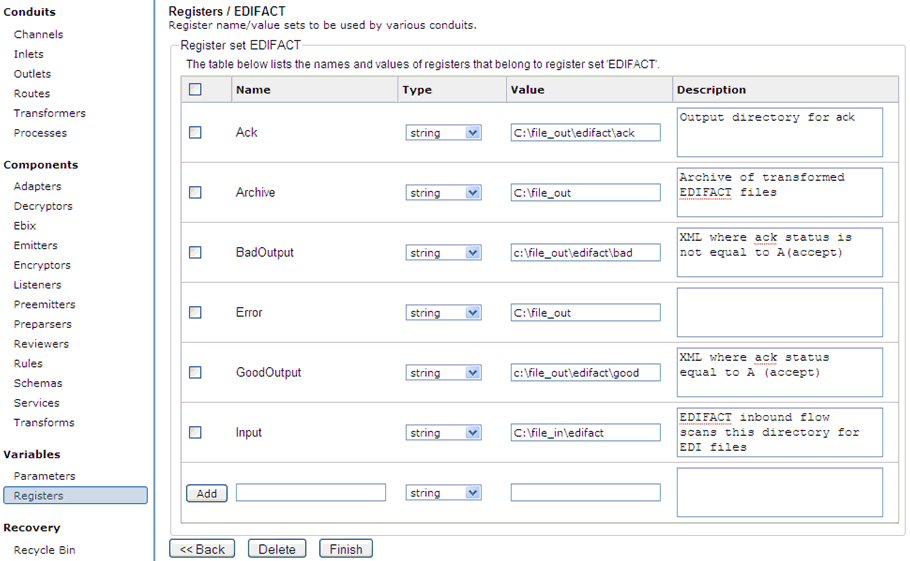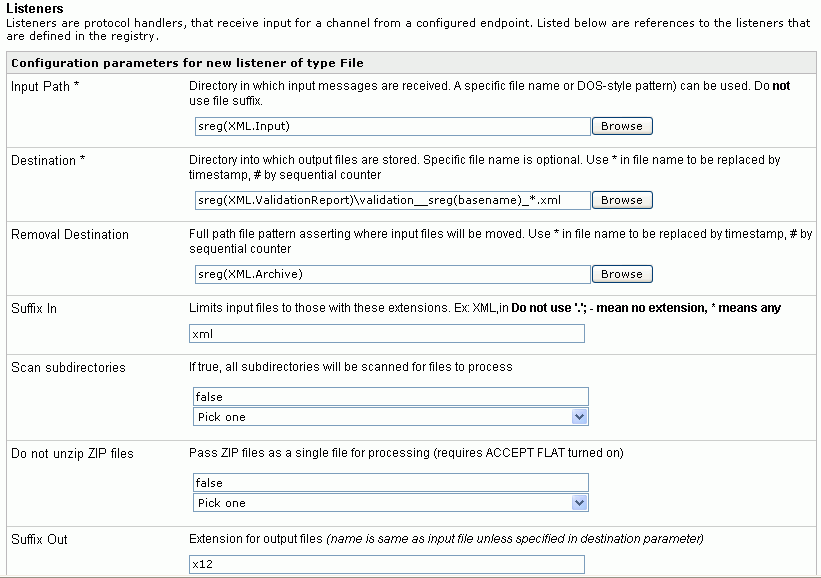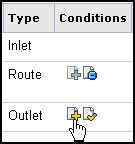-
Drag and drop the Service object from the toolbar to the workspace.
The New Service Object dialog box opens.
-
In the Name field, type XMLToEDIFACTTransformAgent,
and a brief description (optional) in the Description field.
-
Click Next.
The Service Type dialog box opens.
-
Select Class Name and enter com.ibi.agents.XMLToEDIFACTTransformAgent.
-
Click Next.
The Properties dialog box opens.
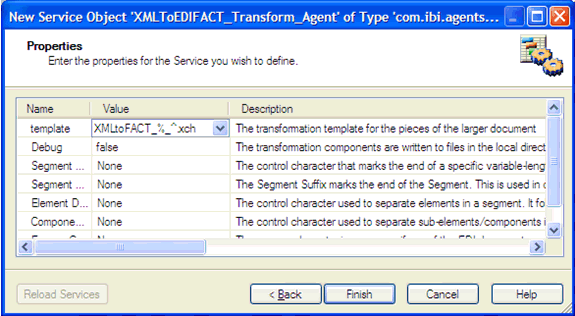
-
For the template parameter, enter the name of the transformation template,
for example, XMLtoFACT_%_^.xch.
-
For the debug parameter, select false from
the drop-down list.
-
Click Finish.
The new Service object (XMLtoEDIFACTTransformAgent) appears
in the workspace.
-
Select the Start object, right-click
the XMLtoEDIFACTTransformAgent object, and
select Relation from the context menu.
The Line Configuration dialog box opens.
-
From the Event drop-down list, select OnCompletion and
click OK.
This option indicates that there are no conditions that
affect the path, and that the path between the two objects will
always be followed.
A line appears between the objects to
indicate that a relationship has been established.

-
Drag and drop the File object from the toolbar to the workspace.
The New File Object dialog box opens.
-
In the Name field, type Write To Error Dir,
and a brief description (optional) in the Description field.
-
Click Next.
The File Type dialog box opens.
-
From the Type drop-down list, select File Write.
-
Click Next.
The Properties dialog box opens.

-
For the Target Directory parameter, enter a location where
error data will be written, for example, sreg(XML.Error).
-
For the File Pattern parameter, enter error__sreg(basename)__*.xml.
-
For the Return parameter, select input from the
drop-down list.
-
Click Finish.
The new File object (Write To Error Dir) appears in the workspace.
-
Select the XMLtoEDIFACTTransformAgent object,
right-click the Write To Error Dir object,
and select Relation from the context menu.
The Line Configuration dialog box opens.
-
From the Event drop-down list, select OnFailure and
click OK.
A line appears between the objects to indicate that a relationship
has been established.
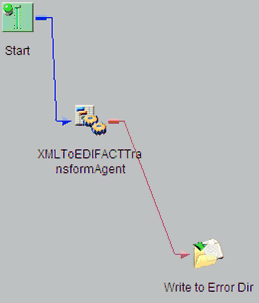
-
Drag and drop the End object from the toolbar to the workspace.
The End Name and Description dialog box opens.
-
In the Name field, type End_Fail, and
a brief description (optional) in the Description field.
-
Click Next.
The End Name Schema dialog box opens.
-
Since no schemas are used in this processing path (that is,
the process flow will not be exposed as a web service), from the
Schema drop-down list, select None.
-
Click Next.
The Properties dialog box opens.
-
Click Finish to accept the default values
and close the dialog box.
The new End_Fail object appears in the workspace.
-
Select the Write To Error Dir object,
right-click the End_Fail object, and select Relation from
the drop-down list.
The Line Configuration dialog box opens.
-
From the Event drop-down list, select OnCompletion and
click OK.
A line appears between the objects to indicate that
a relationship has been established.

-
Drag and drop the Service object from the toolbar to the workspace.
The New Service Object dialog box opens.
-
In the Name field, type XDEDIFACTValidationReportAgent,
and a brief description (optional) in the Description field.
-
Click Next.
The Service Type dialog box opens.
-
Select Class Name and enter com.ibi.agents.XDEDIFACTValidationReportAgent.
-
Click Next.
The Properties dialog box opens.
-
Configure the available parameters according to your requirements.
-
Click Finish.
The new Service object (XDEDIFACTValidationReportAgent)
appears in the workspace.
-
Select the XMLtoEDIFACTTransformAgent object,
right-click the XDEDIFACTValidationReportAgent object, and
select Relation from the context menu.
The Line Configuration dialog box opens.
-
From the Event drop-down list, select OnCompletion and
click OK.
A line appears between the objects to indicate that a relationship
has been established.
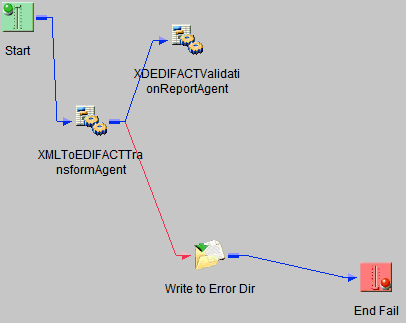
-
Drag and drop the Decision Test object from the toolbar to
the workspace.
The New Test Object dialog box opens.
-
In the Name field, type Decision Test,
and a brief description (optional) in the Description field.
-
Click Next.
The Test Operands dialog box opens.
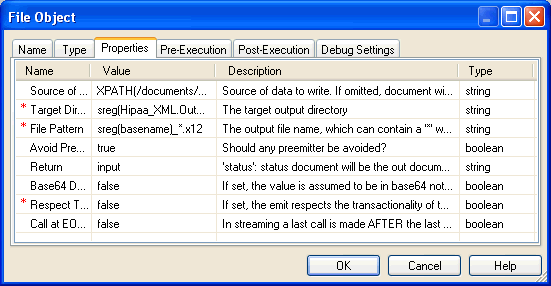
-
In the Operand One field, enter the following:
XPATH(/documents/ValidationReport/Report/Errors/error)
-
From the Operation drop-down list, select Is Not Null.
-
Click Next.
The Value Occurrences dialog box opens.
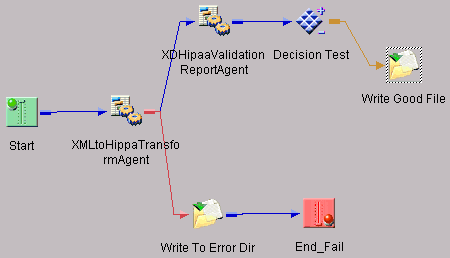
-
Ensure that Unique is selected from
the available options.
-
Click Finish.
The new Decision Test object appears in the workspace.
-
Select the XDEDIFACTValidationReportAgent object,
right-click the Decision Test object, and
select Relation from the context menu.
The Line Configuration dialog box opens.
-
From the Event drop-down list, select OnCompletion and
click OK.
A line appears between the objects to indicate that a relationship
has been established.
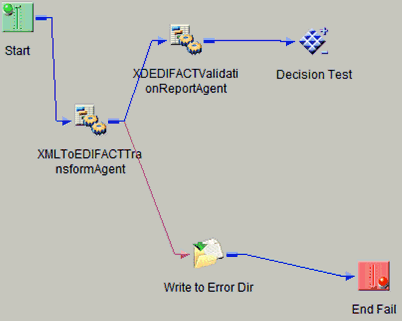
-
Drag and drop the File object from the toolbar to the workspace.
The New File Object dialog box opens.
-
In the Name field, type Write Good File,
and a brief description (optional) in the Description field.
-
Click Next.
The File Type dialog box opens.
-
From the Type drop-down list, select File Write.
-
Click Next.
The Properties dialog box opens.

-
For the Source of Data parameter, enter the following:
XPATH(/documents/output)
-
For the Target Directory parameter, enter the following location
where valid data will be written:
sreg(XML.Output)
-
For the File Pattern parameter, enter the following:
sreg(basename)__*.edifact
-
For the Return parameter, select input from the
drop-down list.
-
Click Finish.
The new File object (Write Good File) appears in the workspace.
-
Select the Decision Test object, right-click
the Write Good File object, and select Relation from
the context menu.
The Line Configuration dialog box opens.
-
From the Event drop-down list, select OnCustom.
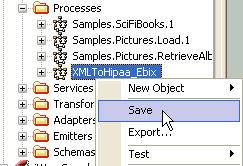
-
In the Case of section, select false.
-
Click OK.
A line appears between the objects to indicate that a relationship
has been established.
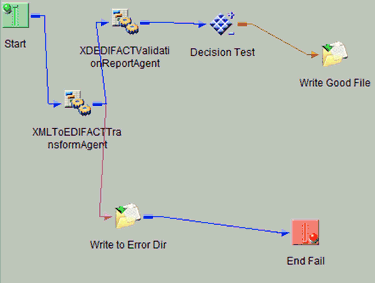
-
Drag and drop the End object from the toolbar to the workspace.
The End Name and Description dialog box opens.
-
In the Name field, type End_Success,
and a brief description (optional) in the Description field.
-
Click Next.
The End Name Schema dialog box opens.
-
Since no schemas are used in this processing path (that is,
the process flow will not be exposed as a web service), from the
Schema drop-down list, select None.
-
Click Next.
The Properties dialog box opens.
-
Click Finish to accept the default values
and close the dialog box.
The new End_Success object appears in the workspace.
-
Select the Write Good File object, right-click
the End_Success object, and select Relation from
the drop-down list.
The Line Configuration dialog box opens.
-
From the Event drop-down list, select OnCompletion and
click OK.
A line appears between the objects to indicate that
a relationship has been established.

-
Select the Decision Test object, right-click
the End_Success object, and select Relation from
the context menu.
The Line Configuration dialog box opens.
-
From the Event drop-down list, select OnCustom.
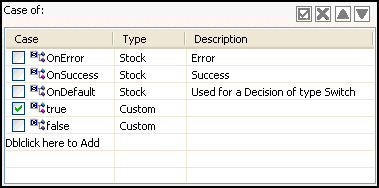
-
In the Case of section, select true.
-
Click OK.
A line appears between the objects to indicate that a relationship
has been established.
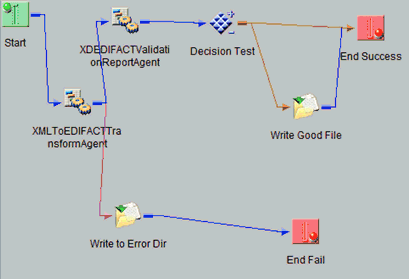
The
process flow is now complete.
-
To save the process flow, right-click the XMLToEDIFACT_Ebix node
in the left pane and select Save from the
context menu.
Now you need to validate the process flow and publish it
to the Registry of the iWay Service Manager Administration Console
for use in the route of a channel for outbound processing.
Validating
a process flow ensures that its structure is correct. Publishing
a process flow makes it available in the Registry for use in a channel
configuration. For instructions on validating and publishing the
process flow, see the iWay Integration Tools Designer User's
Guide.
-
Close iIT Designer.
Your next step is to add a new route to the Registry using
the iWay Service Manager Administration Console and associate the
process flow with it.




